ORM
ORM(Object Relational Mapping)是一种将对象模型与关系数据库之间进行映射的技术,它可以让开发者使用面向对象的方式来操作数据库,而无需编写SQL语句。
常见的ORM框架有
- Hibernate
- MyBatis
- Spring Data JPA
Mybatis
简介
图形化客户端工具(如:idea、datagrip)操作数据库:
在图形化客户端工具中编写SQL查询代码,发送给数据库执行,数据库执行后返回操作结果。
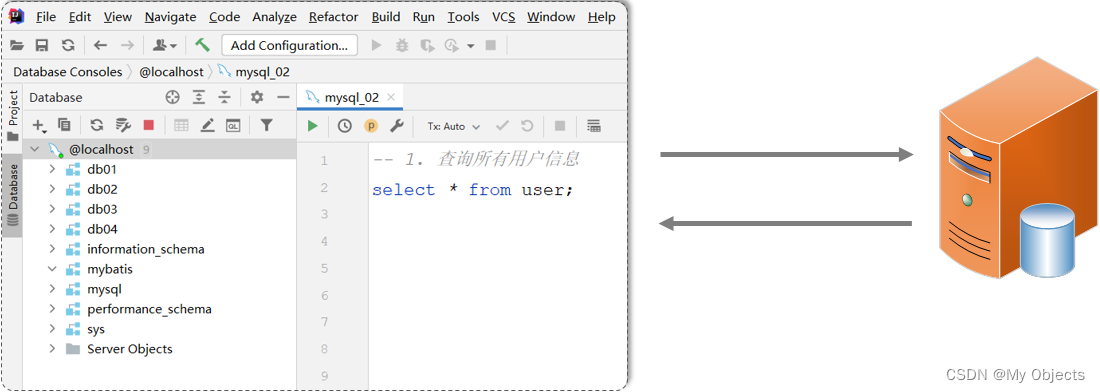
图形化工具会把数据库执行的查询结果,使用表格的形式展现出来
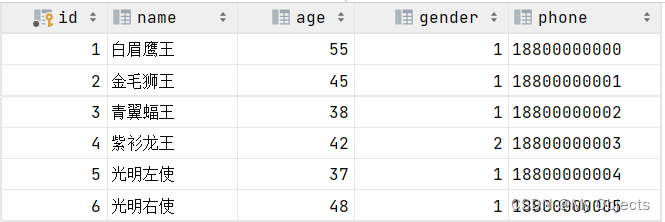
在客户端工具中,编写增删改查的SQL语句,发给MySQL数据库管理系统,由数据库管理系统执行SQL语句并返回执行结果。
增删改操作:返回受影响行数
查询操作:返回结果集(查询的结果)
Java程序操作数据库主流的方式是:Mybatis。
什么是MyBatis?
-
MyBatis是一款优秀的
持久层
框架
,用于简化JDBC的开发。 -
持久层:指的是就是数据访问层(dao),是用来操作数据库的。

- 框架:是一个半成品软件,是一套可重用的、通用的、软件基础代码模型。在框架的基础上进行软件开发更加高效、规范、通用、可拓展。
SpringBoot整合MyBatis
使用Mybatis操作数据库,就是在Mybatis中编写SQL查询代码,发送给数据库执行,数据库执行后返回结果。
![[外链图片转存失败,源站可能有防盗链机制,建议将图片保存下来直接上传(img-vfE7g4Tp-1687135063243)(REDEME.assets/image-20221209155904370.png)]](https://img-blog.csdnimg.cn/a402a93389634243ae2fc464ce21323c.png)
Mybatis会把数据库执行的查询结果,使用实体类封装起来(一行记录对应一个实体类对象)
![[外链图片转存失败,源站可能有防盗链机制,建议将图片保存下来直接上传(img-DqSJZpkY-1687135063244)(REDEME.assets/image-20221209161623051.png)]](https://img-blog.csdnimg.cn/30631352bdd2440298af632489afade9.png)
Mybatis操作数据库的步骤:
-
准备工作(创建springboot工程、数据库表user、实体类User)
-
引入Mybatis的相关依赖,配置Mybatis(数据库连接信息)
-
编写SQL语句(注解/XML)
准备工作
创建springboot工程
创建springboot工程,并导入 mybatis的起步依赖、mysql的驱动包。
![[外链图片转存失败,源站可能有防盗链机制,建议将图片保存下来直接上传(img-44JrX8j9-1687135063244)(REDEME.assets/image-20221209162827242.png)]](https://img-blog.csdnimg.cn/74034a07c56548d286df1df325310b61.png)
![[外链图片转存失败,源站可能有防盗链机制,建议将图片保存下来直接上传(img-0OboqBGQ-1687135063245)(REDEME.assets/image-20221209163123443.png)]](https://img-blog.csdnimg.cn/c9aadded990245ce8acbf4d972ec7adb.png)
项目工程创建完成后,自动在pom.xml文件中,导入Mybatis依赖和MySQL驱动依赖
<!-- 仅供参考:只粘贴了pom.xml中部分内容 -->
<dependencies>
<!-- mybatis起步依赖 -->
<dependency>
<groupId>org.mybatis.spring.boot</groupId>
<artifactId>mybatis-spring-boot-starter</artifactId>
<version>2.3.0</version>
</dependency>
<!-- mysql驱动包依赖 -->
<dependency>
<groupId>com.mysql</groupId>
<artifactId>mysql-connector-j</artifactId>
<scope>runtime</scope>
</dependency>
<!-- spring单元测试 (集成了junit) -->
<dependency>
<groupId>org.springframework.boot</groupId>
<artifactId>spring-boot-starter-test</artifactId>
<scope>test</scope>
</dependency>
</dependencies>
数据准备
创建用户表user,并创建对应的实体类User。
- 用户表:
-- 用户表
create table user(
id int unsigned primary key auto_increment comment 'ID',
name varchar(100) comment '姓名',
age tinyint unsigned comment '年龄',
gender tinyint unsigned comment '性别, 1:男, 2:女',
phone varchar(11) comment '手机号'
) comment '用户表';
-- 测试数据
insert into user(id, name, age, gender, phone) VALUES (null,'白眉鹰王',55,'1','18800000000');
insert into user(id, name, age, gender, phone) VALUES (null,'金毛狮王',45,'1','18800000001');
insert into user(id, name, age, gender, phone) VALUES (null,'青翼蝠王',38,'1','18800000002');
insert into user(id, name, age, gender, phone) VALUES (null,'紫衫龙王',42,'2','18800000003');
insert into user(id, name, age, gender, phone) VALUES (null,'光明左使',37,'1','18800000004');
insert into user(id, name, age, gender, phone) VALUES (null,'光明右使',48,'1','18800000005');
![[外链图片转存失败,源站可能有防盗链机制,建议将图片保存下来直接上传(img-RvuK54x0-1687135063245)(REDEME.assets/image-20220901121116813.png)]](https://img-blog.csdnimg.cn/fd19439fe3c14776a15179586be58c7b.png)
-
实体类
-
实体类的属性名与表中的字段名一一对应。
-
实体类属性采用驼峰命名
-
public class User {
private Integer id; //id(主键)
private String name; //姓名
private Short age; //年龄
private Short gender; //性别
private String phone; //手机号
//省略GET, SET方法
}
![[外链图片转存失败,源站可能有防盗链机制,建议将图片保存下来直接上传(img-CJmy612h-1687135063246)(REDEME.assets/image-20221209170354143.png)]](https://img-blog.csdnimg.cn/9320d1a001a94aa094d5fc9f9b28fd70.png)
配置Mybatis
![> [外链图片转存失败,源站可能有防盗链机制,建议将图片保存下来直接上传(img-ReSbHNKJ-1687135063247)(REDEME.assets/image-20221209172527630.png)]](https://img-blog.csdnimg.cn/da5b7b29f898466083b366d5197e739d.png)
连接数据库的四大参数:
- MySQL驱动类
- 登录名
- 密码
- 数据库连接字符串
在Mybatis中要连接数据库,同样也需要以上4个参数配置。
在springboot项目中,可以编写application.properties文件,配置数据库连接信息。
连接数据库需要配置数据库连接的基本信息,包括:driver-class-name、url 、username,password。
application.properties:
#驱动类名称
spring.datasource.driver-class-name=com.mysql.cj.jdbc.Driver
#数据库连接的url
spring.datasource.url=jdbc:mysql://localhost:3306/mybatis
#连接数据库的用户名
spring.datasource.username=root
#连接数据库的密码
spring.datasource.password=1234
SpringBoot
版本低于2.4.3(不含),Mysql驱动版本大于8.0时,需要在url中配置时区
jdbc:mysql://localhost:3306/mybatis?serverTimezone=UTC
,或在MySQL数据库端配置时区UTC是标准时区,和中国的时间差8小时,可以将其修改为
Asia/Shanghai
编写SQL语句
在创建出来的springboot工程中,在引导类所在包下,在创建一个包 mapper。在mapper包下创建一个接口 UserMapper ,这是一个持久层接口(Mybatis的持久层接口规范一般都叫 XxxMapper)。
![[外链图片转存失败,源站可能有防盗链机制,建议将图片保存下来直接上传(img-KpsFaMsC-1687135063247)(REDEME.assets/image-20221209175843651.png)]](https://img-blog.csdnimg.cn/b37ee19896484a7c80f083f9ea7ef751.png)
UserMapper:
import com.itheima.pojo.User;
import org.apache.ibatis.annotations.Mapper;
import org.apache.ibatis.annotations.Select;
import java.util.List;
@Mapper
public interface UserMapper {
//查询所有用户数据
@Select("select id, name, age, gender, phone from user")
public List<User> list();
}
@Mapper注解:表示是mybatis中的Mapper接口
- 程序运行时:框架会自动生成接口的实现类对象(代理对象),并给交Spring的IOC容器管理
Dao接口要想被容器扫描到,有两种解决方案:
@SpringBootApplication //@MapperScan("com.myself.dao") public class DemoApplication { public static void main(String[] args) { SpringApplication.run(DemoApplication.class, args); } }
- 方案一:在Dao接口上添加
@Mapper
注解,并且确保Dao处在引导类所在包或其子包中
- 需要在每一个Dao接口中添加注解
- 方案二:在引导类上添加
@MapperScan
注解,其属性为所要扫描的Dao所在包
- 只需要写一次,则指定包下的所有Dao接口都能被扫描到,
@Mapper
可以不写。@Select注解:用于编写select查询操作的SQL语句
@Delete注解:用于编写delete操作的SQL语句
@Update注解:用于编写update操作的SQL语句
@Insert注解:用于编写insert操作的SQL语句
单元测试
在创建出来的SpringBoot工程中,在src下的test目录下,已经自动帮我们创建好了测试类 ,并且在测试类上已经添加了注解 @SpringBootTest,代表该测试类已经与SpringBoot整合。
该测试类在运行时,会自动通过引导类加载Spring的环境(IOC容器)。我们要测试那个bean对象,就可以直接通过@Autowired注解将其注入进行测试
测试类代码如下:
@SpringBootTest
public class MybatisQuickstartApplicationTests {
@Autowired
private UserMapper userMapper;
@Test
public void testList(){
List<User> userList = userMapper.list();
for (User user : userList) {
System.out.println(user);
}
}
}
运行结果:
User{id=1, name='白眉鹰王', age=55, gender=1, phone='18800000000'} User{id=2, name='金毛狮王', age=45, gender=1, phone='18800000001'} User{id=3, name='青翼蝠王', age=38, gender=1, phone='18800000002'} User{id=4, name='紫衫龙王', age=42, gender=2, phone='18800000003'} User{id=5, name='光明左使', age=37, gender=1, phone='18800000004'} User{id=6, name='光明右使', age=48, gender=1, phone='18800000005'}
解决SQL警告与提示
默认在UserMapper接口上加的@Select注解中编写SQL语句是没有提示的。
如果想让idea给我们提示对应的SQL语句,我们需要在IDEA中配置与MySQL数据库的链接。
![[外链图片转存失败,源站可能有防盗链机制,建议将图片保存下来直接上传(img-NoUuG8Wd-1687135063248)(REDEME.assets/image-20221210143348119.png)]](https://img-blog.csdnimg.cn/00b34035a64148b89983c68932990c82.png)
不识别表名(列名):
![[外链图片转存失败,源站可能有防盗链机制,建议将图片保存下来直接上传(img-CpcIoT67-1687135063248)(REDEME.assets/image-20221210143934318.png)]](https://img-blog.csdnimg.cn/c65498a0eb3c4b21aee7eb5e692477e0.png)
产生原因:Idea和数据库没有建立连接,不识别表信息
解决方案:在Idea中配置MySQL数据库连接
![[外链图片转存失败,源站可能有防盗链机制,建议将图片保存下来直接上传(img-uH05XxIj-1687135063249)(REDEME.assets/image-20221210144139792.png)]](https://img-blog.csdnimg.cn/0b3ae65e09c349229b2b0a9373f64879.png)
在配置的时候指定连接那个数据库,如上图所示连接的就是mybatis数据库。
主键返回
概念:在数据添加成功后,需要获取插入数据库数据的主键。
- 默认情况下,执行插入操作时,是不会主键值返回的。
- 需要在Mapper接口中的方法上添加一个Options注解,并在注解中指定属性useGeneratedKeys=true和keyProperty=“实体类属性名”
示例:
@Mapper
public interface EmpMapper {
//会自动将生成的主键值,赋值给emp对象的id属性
@Options(useGeneratedKeys = true,keyProperty = "id")
@Insert("insert into user(id, name, age, gender, phone) VALUES (#{id},#{name},#{age},#{gender},#{phone}")
public void insert(User user);
}
JDBC
简介
java语言操作数据库呢,只能通过一种方式:使用sun公司提供的 JDBC 规范。
Mybatis框架,就是对原始的JDBC程序的封装。
JDBC: ( Java DataBase Connectivity ),使用Java语言操作关系型数据库的一套API。
![[外链图片转存失败,源站可能有防盗链机制,建议将图片保存下来直接上传(img-Tv2RjMBF-1687135063249)(REDEME.assets/image-20221210144811961.png)]](https://img-blog.csdnimg.cn/1bdf9b1ff49f4286800483e8aaeb7fb1.png)
本质:
sun公司官方定义的一套操作所有关系型数据库的规范,即接口。
各个数据库厂商去实现这套接口,提供数据库驱动jar包。
我们可以使用这套接口(JDBC)编程,真正执行的代码是驱动jar包中的实现类。
代码
原始的JDBC程序操作数据库操作步骤:
- 注册驱动
- 获取连接对象
- 执行SQL语句,返回执行结果
- 处理执行结果
- 释放资源
在pom.xml文件中已引入MySQL驱动依赖,我们直接编写JDBC代码即可
JDBC具体代码实现:
import com.itheima.pojo.User;
import org.junit.jupiter.api.Test;
import java.sql.Connection;
import java.sql.DriverManager;
import java.sql.ResultSet;
import java.sql.Statement;
import java.util.ArrayList;
import java.util.List;
public class JdbcTest {
@Test
public void testJdbc() throws Exception {
//1. 注册驱动
Class.forName("com.mysql.cj.jdbc.Driver");
//2. 获取数据库连接
String url="jdbc:mysql://127.0.0.1:3306/mybatis";
String username = "root";
String password = "1234";
Connection connection = DriverManager.getConnection(url, username, password);
//3. 执行SQL
Statement statement = connection.createStatement(); //操作SQL的对象
String sql="select id,name,age,gender,phone from user";
ResultSet rs = statement.executeQuery(sql);//SQL查询结果会封装在ResultSet对象中
List<User> userList = new ArrayList<>();//集合对象(用于存储User对象)
//4. 处理SQL执行结果
while (rs.next()){
//取出一行记录中id、name、age、gender、phone下的数据
int id = rs.getInt("id");
String name = rs.getString("name");
short age = rs.getShort("age");
short gender = rs.getShort("gender");
String phone = rs.getString("phone");
//把一行记录中的数据,封装到User对象中
User user = new User(id,name,age,gender,phone);
userList.add(user);//User对象添加到集合
}
//5. 释放资源
statement.close();
connection.close();
rs.close();
//遍历集合
for (User user : userList) {
System.out.println(user);
}
}
}
DriverManager(类):数据库驱动管理类。
作用:
注册驱动
创建java代码和数据库之间的连接,即获取Connection对象
Connection(接口):建立数据库连接的对象
- 作用:用于建立java程序和数据库之间的连接
Statement(接口): 数据库操作对象(执行SQL语句的对象)。
- 作用:用于向数据库发送sql语句
ResultSet(接口):结果集对象(一张虚拟表)
- 作用:sql查询语句的执行结果会封装在ResultSet中
问题分析
原始的JDBC程序,存在以下几点问题:
-
数据库链接的四要素(驱动、链接、用户名、密码)全部
硬编码
在java代码中 - 查询结果的解析及封装非常繁琐
-
每一次查询数据库都需要获取连接,操作完毕后释放连接, 资源浪费, 性能降低
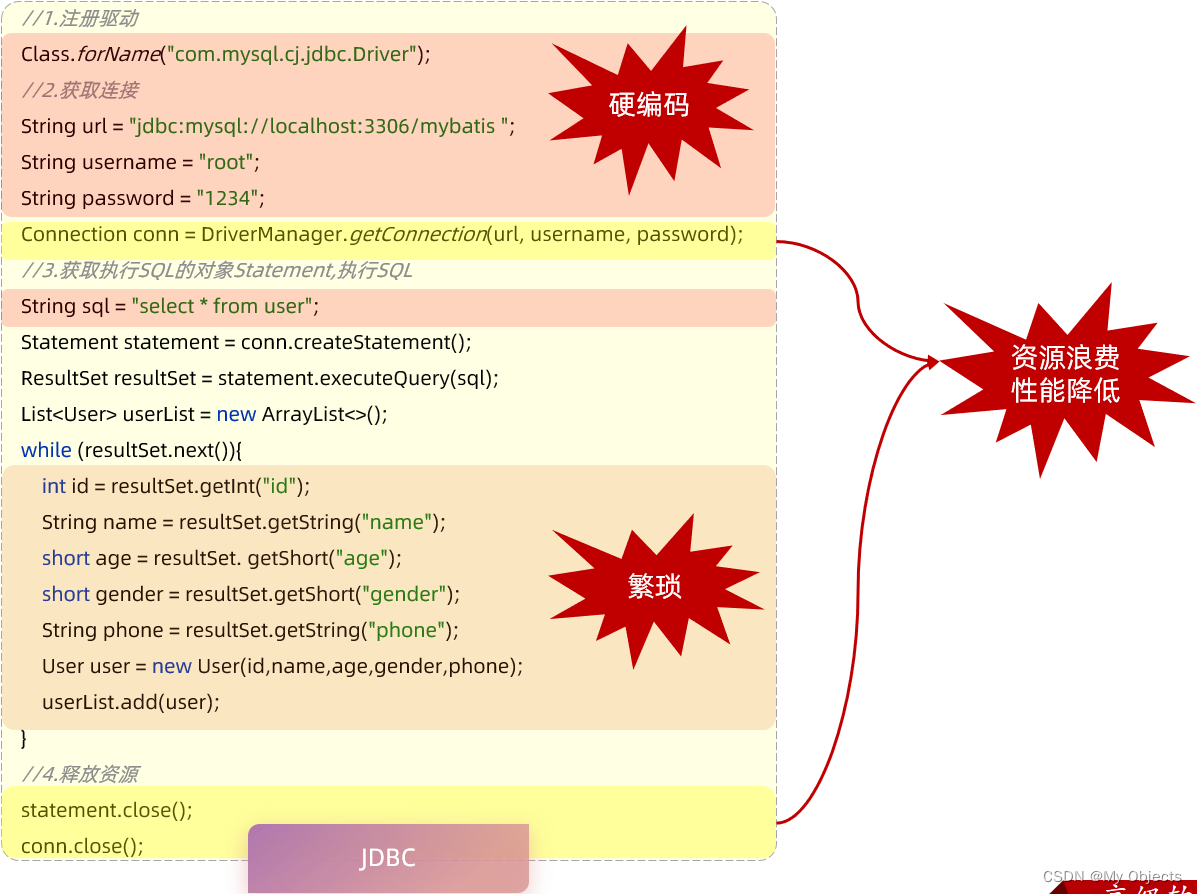
技术对比
-
数据库连接四要素(驱动、链接、用户名、密码),都配置在springboot默认的配置文件 application.properties中
-
查询结果的解析及封装,由mybatis自动完成映射封装
-
在mybatis中使用了数据库连接池技术,从而避免了频繁的创建连接、销毁连接而带来的资源浪费。
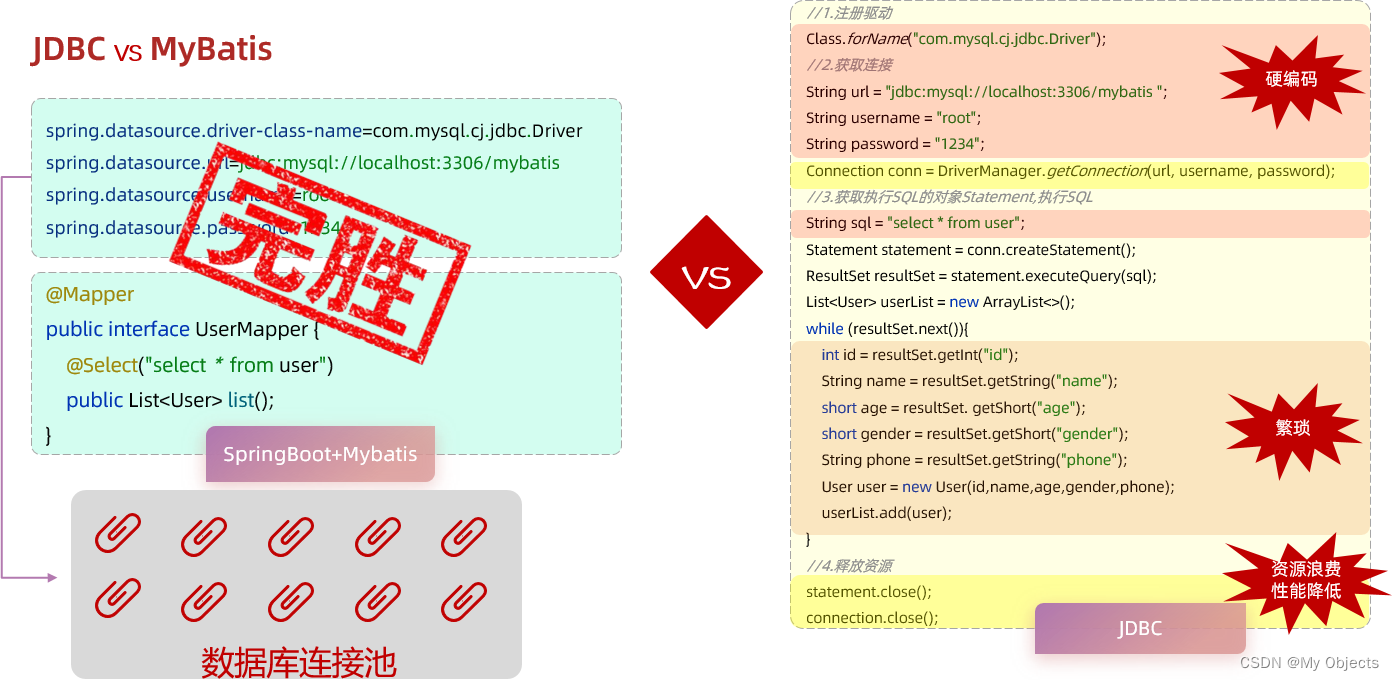
使用SpringBoot+Mybatis的方式操作数据库,能够提升开发效率、降低资源浪费
使用Mybatis开发持久层程序操作数据库时,需要重点关注:
-
application.properties
#驱动类名称 spring.datasource.driver-class-name=com.mysql.cj.jdbc.Driver #数据库连接的url spring.datasource.url=jdbc:mysql://localhost:3306/mybatis #连接数据库的用户名 spring.datasource.username=root #连接数据库的密码 spring.datasource.password=1234 -
Mapper接口(编写SQL语句)
@Mapper public interface UserMapper { @Select("select id, name, age, gender, phone from user") public List<User> list(); }
数据库连接池
mybatis中,使用了数据库连接池技术,避免频繁的创建连接、销毁连接而带来的资源浪费。
简介

没有使用数据库连接池:
- 客户端执行SQL语句:要先创建一个新的连接对象,然后执行SQL语句,SQL语句执行后又需要关闭连接对象从而释放资源,每次执行SQL时都需要创建连接、销毁链接,这种频繁的重复创建销毁的过程是比较耗费计算机的性能。
![[外链图片转存失败,源站可能有防盗链机制,建议将图片保存下来直接上传(img-79P8ZJR8-1687135063251)(REDEME.assets/image-20221210161016314.png)]](https://img-blog.csdnimg.cn/a90d8c58af594252b88bfd04d87402b1.png)
数据库连接池是个容器,负责分配、管理数据库连接(Connection)
- 程序在启动时,会在数据库连接池(容器)中,创建一定数量的Connection对象
允许应用程序重复使用一个现有的数据库连接,而不是再重新建立一个
- 客户端在执行SQL时,先从连接池中获取一个Connection对象,然后在执行SQL语句,SQL语句执行完之后,释放Connection时就会把Connection对象归还给连接池(Connection对象可以复用)
释放空闲时间超过最大空闲时间的连接,来避免因为没有释放连接而引起的数据库连接遗漏
- 客户端获取到Connection对象了,但是Connection对象并没有去访问数据库(处于空闲),数据库连接池发现Connection对象的空闲时间 > 连接池中预设的最大空闲时间,此时数据库连接池就会自动释放掉这个连接对象
数据库连接池的好处:
- 资源重用
- 提升系统响应速度
- 避免数据库连接遗漏
产品
要怎么样实现数据库连接池呢?
-
官方(sun)提供了数据库连接池标准(javax.sql.DataSource接口)
-
功能:获取连接
public Connection getConnection() throws SQLException; -
第三方组织必须按照DataSource接口实现
-
常见的数据库连接池:
- C3P0
- DBCP
- Druid
- Hikari (springboot默认)
现在使用更多的是:Hikari、Druid (性能更优越)
- Hikari(追光者) [默认的连接池]
![[外链图片转存失败,源站可能有防盗链机制,建议将图片保存下来直接上传(img-YLmTNCrS-1687135063252)(REDEME.assets/image-20220901144923251.png)]](https://img-blog.csdnimg.cn/8b54ce31be214eed9c25a6ac383eebff.png)
-
Druid(德鲁伊)
-
Druid连接池是阿里巴巴开源的数据库连接池项目
-
功能强大,性能优秀,是Java语言最好的数据库连接池之一
-
将默认的数据库连接池切换为Druid数据库连接池:
- 在pom.xml文件中引入依赖
<dependency>
<!-- Druid连接池依赖 -->
<groupId>com.alibaba</groupId>
<artifactId>druid-spring-boot-starter</artifactId>
<version>1.2.8</version>
</dependency>
- 在application.properties中引入数据库连接配置
方式1:
spring.datasource.druid.driver-class-name=com.mysql.cj.jdbc.Driver
spring.datasource.druid.url=jdbc:mysql://localhost:3306/mybatis
spring.datasource.druid.username=root
spring.datasource.druid.password=1234
方式2:
spring.datasource.driver-class-name=com.mysql.cj.jdbc.Driver
spring.datasource.url=jdbc:mysql://localhost:3306/mybatis
spring.datasource.username=root
spring.datasource.password=1234
日志
开启Mybatis日志,可以查看到sql语句的执行、执行传递的参数以及执行结果。
-
打开application.properties文件
-
开启mybatis的日志,并指定输出到控制台
#指定mybatis输出日志的位置, 输出控制台
mybatis.configuration.log-impl=org.apache.ibatis.logging.stdout.StdOutImpl
预编译SQL
简介
预编译SQL有两个优势:
- 性能更高
- 更安全(防止SQL注入)

性能更高:预编译SQL,编译一次之后会将编译后的SQL语句缓存起来,后面再次执行这条语句时,不会再次编译。(只是输入的参数不同)
更安全(防止SQL注入):将敏感字进行转义,保障SQL的安全性。
SQL注入
SQL注入:是通过操作输入的数据来修改事先定义好的SQL语句,以达到执行代码对服务器进行攻击的方法。
由于没有对用户输入进行充分检查,而SQL又是拼接而成,在用户输入参数时,在参数中添加一些SQL关键字,达到改变SQL运行结果的目的,也可以完成恶意攻击。
参数占位符
在Mybatis中提供的参数占位符有两种:${…} 、#{…}
-
#{…}
- 执行SQL时,会将#{…}替换为?,生成预编译SQL,会自动设置参数值
- 使用时机:参数传递,都使用#{…}
-
${…}
- 拼接SQL。直接将参数拼接在SQL语句中,存在SQL注入问题
- 使用时机:如果对表名、列表进行动态设置时使用
项目开发中,建议使用#{…},生成预编译SQL,防止SQL注入安全。
如果mapper接口方法形参只有一个基本类型的参数,参数占位符{…}里面的属性名可以随便写,如:#{id}、#{value}。但是建议保持名字一致。
当mapper接口方法形参为引用数据类型的参数时,参数占位符{…}里面写的名称是对象的属性名
数据封装
查询返回的结果中大部分字段是有值的,但deptId,createTime,updateTime这几个字段没有值,而数据库中是有对应的字段值的,这是为什么呢?
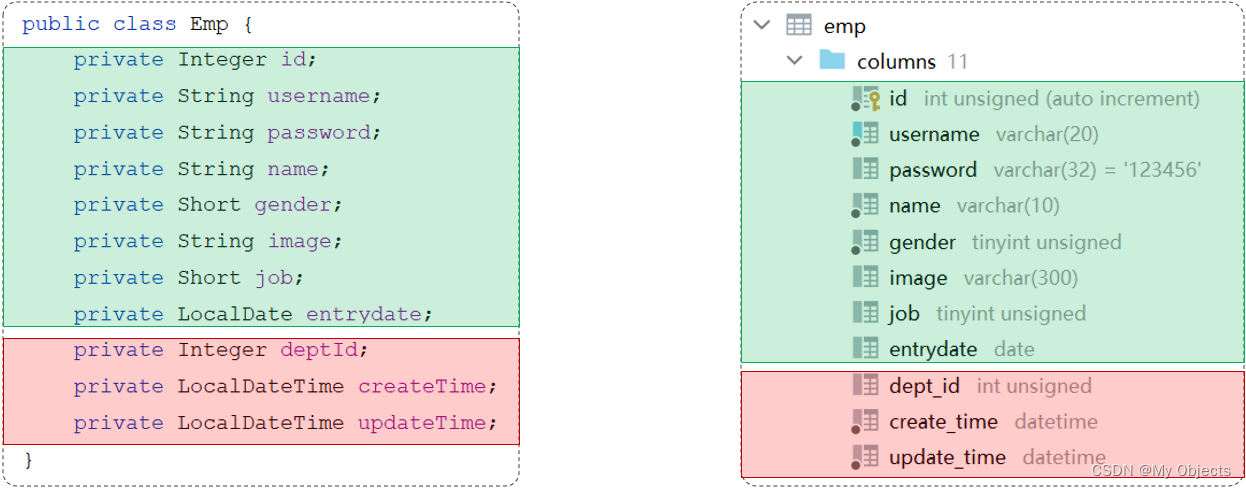
原因如下:
- 实体类属性名和数据库表查询返回的字段名一致,mybatis会自动封装。
- 如果实体类属性名和数据库表查询返回的字段名不一致,不能自动封装。
解决方案:
- 起别名
- 结果映射
- 开启驼峰命名
起别名
:在SQL语句中,对不一样的列名起别名,别名和实体类属性名一样
@Select("select id, username, password, name, gender, image, job, entrydate, " +
"dept_id AS deptId, create_time AS createTime, update_time AS updateTime " +
"from emp " +
"where id=#{id}")
public Emp getById(Integer id);
手动结果映射
:通过 @Results及@Result 进行手动结果映射
@Results({@Result(column = "dept_id", property = "deptId"),
@Result(column = "create_time", property = "createTime"),
@Result(column = "update_time", property = "updateTime")})
@Select("select id, username, password, name, gender, image, job, entrydate, dept_id, create_time, update_time from emp where id=#{id}")
public Emp getById(Integer id);
@Results源代码:
@Documented @Retention(RetentionPolicy.RUNTIME) @Target({ElementType.METHOD}) public @interface Results { String id() default ""; Result[] value() default {}; //Result类型的数组 }@Result源代码:
@Documented @Retention(RetentionPolicy.RUNTIME) @Target({ElementType.METHOD}) @Repeatable(Results.class) public @interface Result { boolean id() default false;//表示当前列是否为主键(true:是主键) String column() default "";//指定表中字段名 String property() default "";//指定类中属性名 Class<?> javaType() default void.class; JdbcType jdbcType() default JdbcType.UNDEFINED; Class<? extends TypeHandler> typeHandler() default UnknownTypeHandler.class; One one() default @One; Many many() default @Many; }
开启驼峰命名(推荐)
:如果字段名与属性名符合驼峰命名规则,mybatis会自动通过驼峰命名规则映射
驼峰命名规则: abc_xyz => abcXyz
- 表中字段名:abc_xyz
- 类中属性名:abcXyz
# 在application.properties中添加:
# 开启mybatis驼峰命名
mybatis.configuration.map-underscore-to-camel-case=true
要使用驼峰命名前提是 实体类的属性 与 数据库表中的字段名严格遵守驼峰命名。
mapper参数名说明
对于基本数据类型,需要保证mapper接口中的形参名和SQL语句中的参数占位符名相同。(引用数据类型则为属性名相同)
当方法中的形参名和SQL语句中的占位符参数名不相同时,就会出现以下问题:
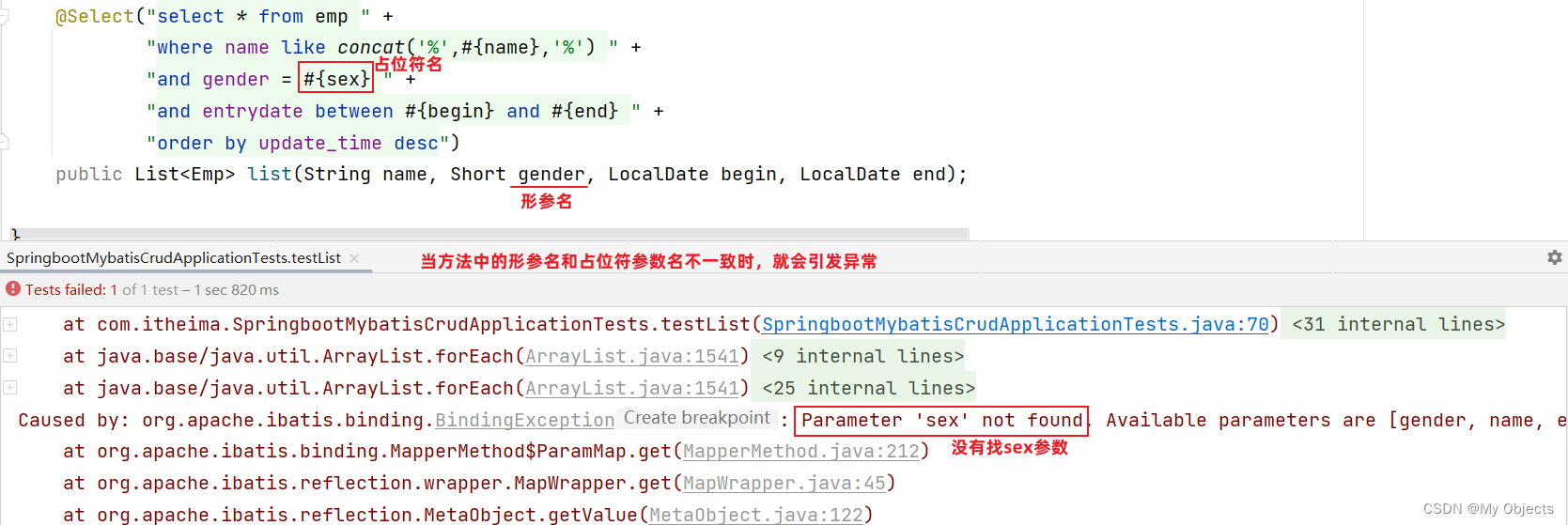
参数名在不同的SpringBoot版本中,处理方案不同:
- 在springBoot的2.x版本(保证参数名一致)
springBoot的父工程对compiler编译插件进行了默认的参数parameters配置,使得在编译时,会在生成的字节码文件中保留原方法形参的名称,所以参数占位符{…}里面可以直接通过形参名获取对应的值

- 在springBoot的1.x版本/单独使用mybatis(使用@Param注解来指定SQL语句中的参数名)

在编译时,生成的字节码文件当中,不会保留Mapper接口中方法的形参名称,而是使用var1、var2、…这样的形参名字,此时要获取参数值时,就要通过@Param注解来指定SQL语句中的参数名

XML配置文件
Mybatis的开发有两种方式:
- 注解
- XML
规范
使用Mybatis的注解,主要是来完成一些简单的增删改查功能。如果需要实现复杂的SQL功能,建议使用XML来配置映射语句,也就是将SQL语句写在XML配置文件中。
Mybatis使用XML映射文件方式开发规范:
-
XML映射文件的名称与Mapper接口名称一致,并且将XML映射文件和Mapper接口放置在相同包下(同包同名)
-
XML映射文件的namespace属性为Mapper接口全限定名一致
-
XML映射文件中sql语句的id与Mapper接口中的方法名一致,并保持返回类型一致。
<select>标签:就是用于编写select查询语句的。
<delete>标签:就是用于编写delete查询语句的。
<insert>标签:就是用于编写insert查询语句的。
<update>标签:就是用于编写update查询语句的。
- resultType属性,指的是查询返回的单条记录所封装的类型。
实现
第1步:创建XML映射文件
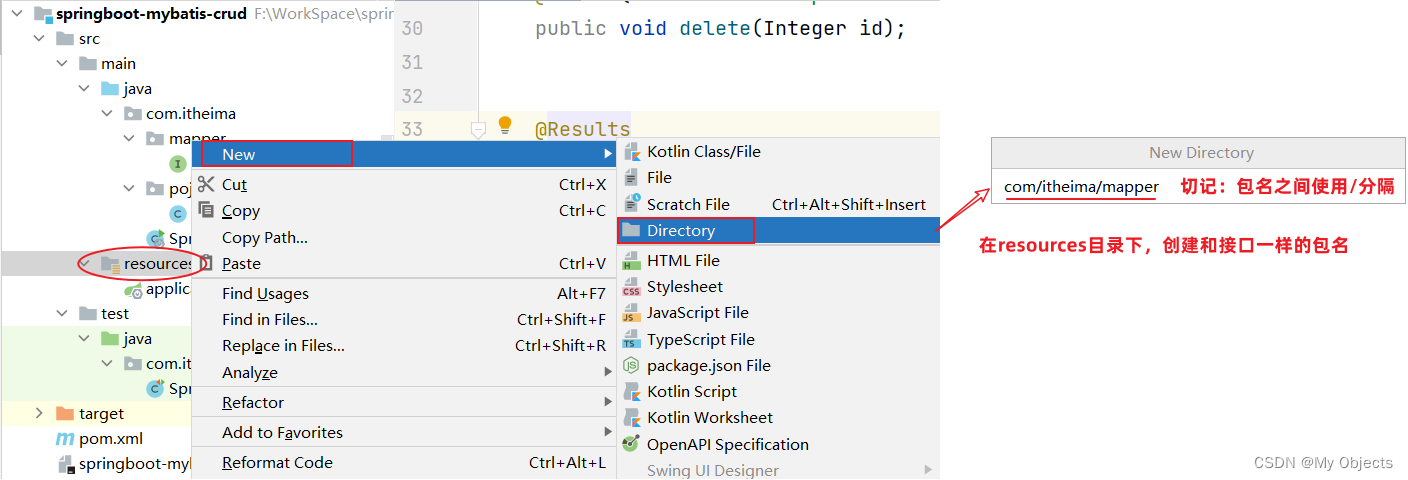

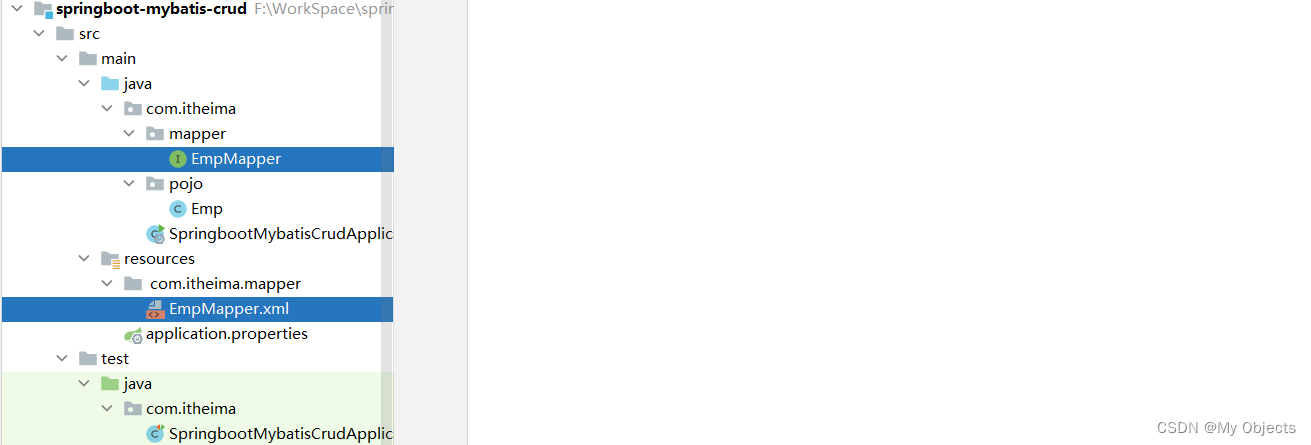
第2步:编写XML映射文件
xml映射文件中的dtd约束,直接从mybatis官网复制即可
<?xml version="1.0" encoding="UTF-8" ?>
<!DOCTYPE mapper
PUBLIC "-//mybatis.org//DTD Mapper 3.0//EN"
"https://mybatis.org/dtd/mybatis-3-mapper.dtd">
<mapper namespace="">
</mapper>
配置:XML映射文件的namespace属性为Mapper接口全限定名
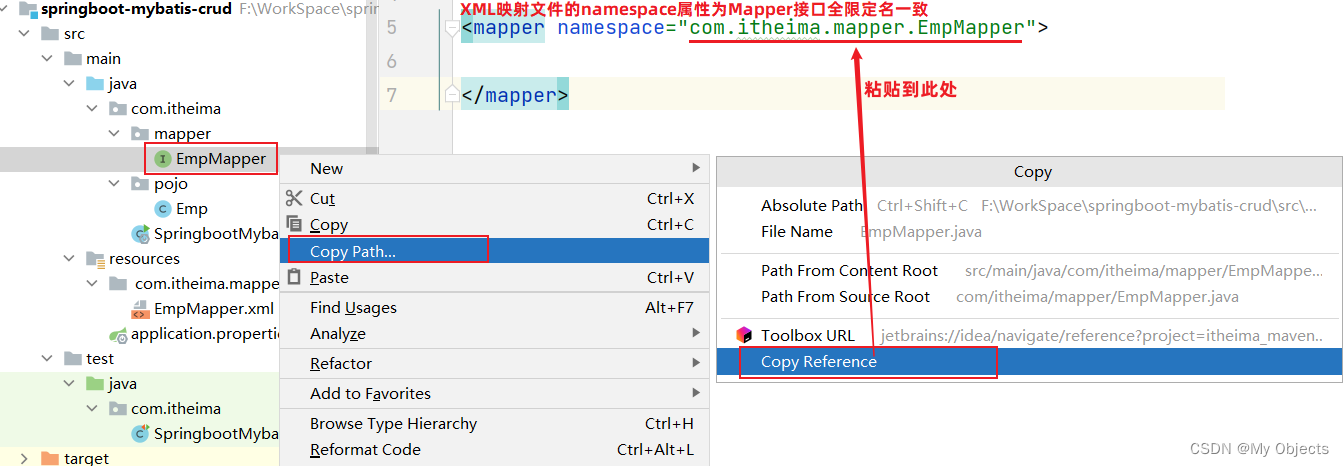
配置:XML映射文件中sql语句的id与Mapper接口中的方法名一致,并保持返回类型一致
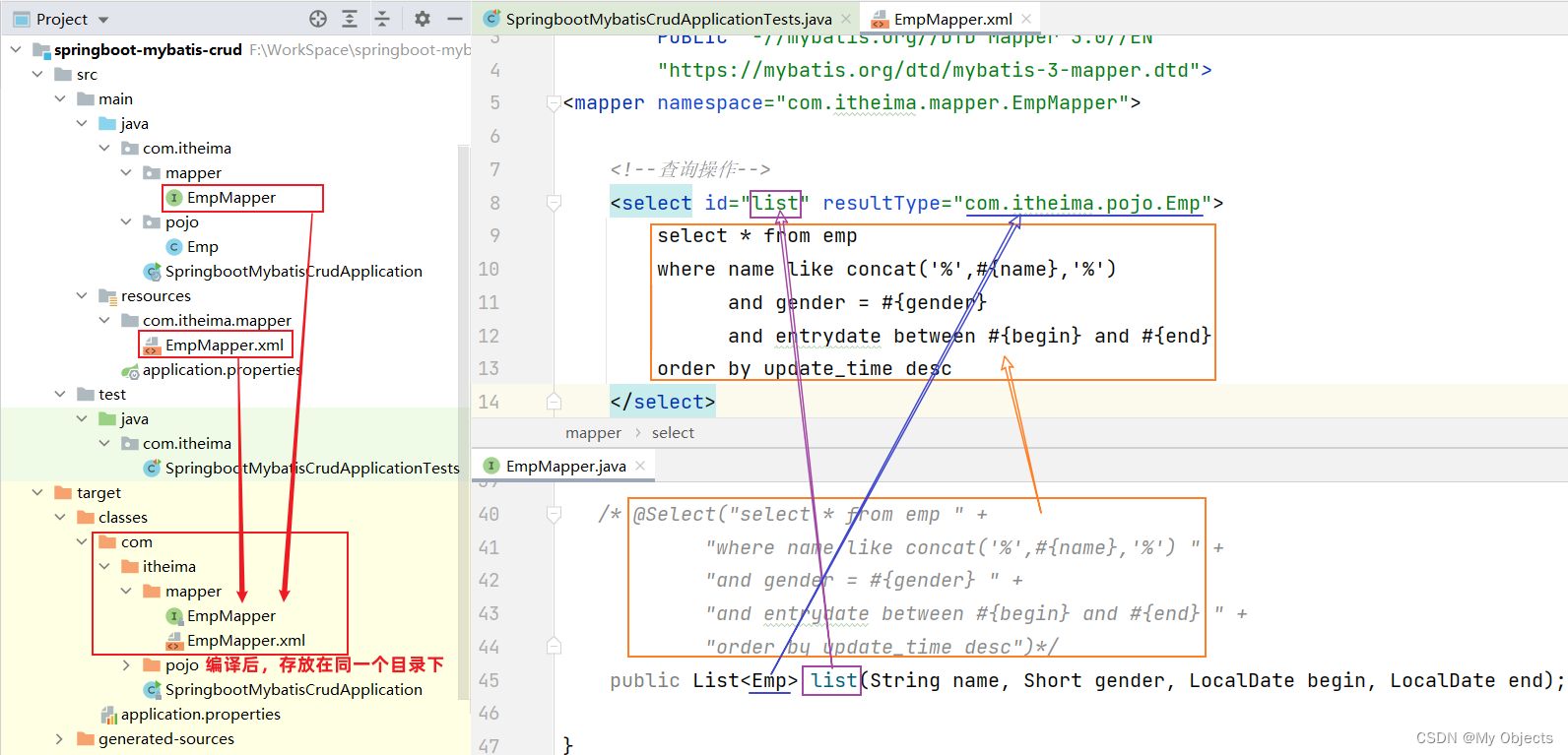
<?xml version="1.0" encoding="UTF-8" ?>
<!DOCTYPE mapper
PUBLIC "-//mybatis.org//DTD Mapper 3.0//EN"
"https://mybatis.org/dtd/mybatis-3-mapper.dtd">
<mapper namespace="com.itheima.mapper.EmpMapper">
<!--查询操作-->
<select id="list" resultType="com.itheima.pojo.Emp">
select * from emp
where name like concat('%',#{name},'%')
and gender = #{gender}
and entrydate between #{begin} and #{end}
order by update_time desc
</select>
</mapper>
MybatisX的使用
MybatisX是一款基于IDEA的快速开发Mybatis的插件,为效率而生。
MybatisX的安装:

可以通过MybatisX快速定位:
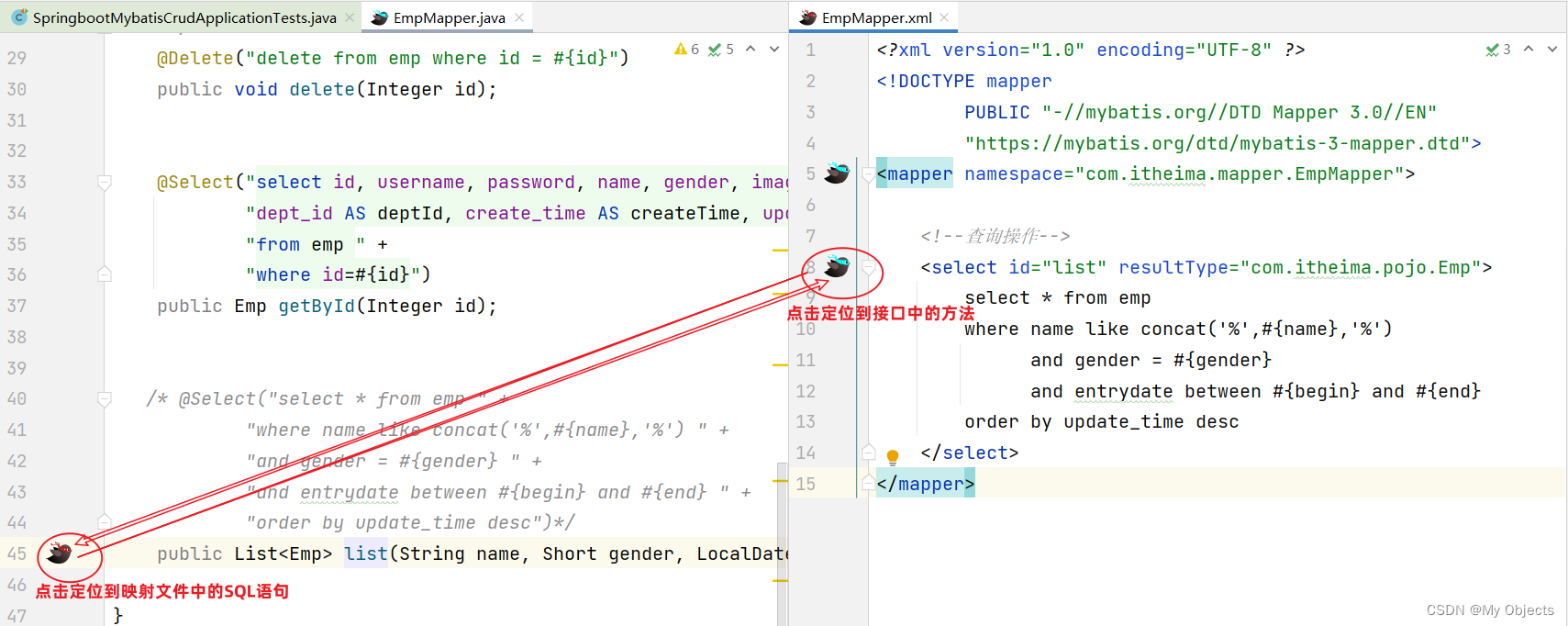
动态SQL
SQL语句会随着用户的输入或外部条件的变化而变化
if、where
<if>
:用于判断条件是否成立。使用test属性进行条件判断,如果条件为true,则拼接SQL。
<if test="条件表达式">
要拼接的sql语句
</if>
<select id="list" resultType="com.itheima.pojo.Emp">
select * from emp
where
<if test="name != null">
name like concat('%',#{name},'%')
</if>
<if test="gender != null">
and gender = #{gender}
</if>
<if test="begin != null and end != null">
and entrydate between #{begin} and #{end}
</if>
order by update_time desc
</select>
<where>
只会在子元素有内容的情况下才插入where子句,而且会自动去除子句的开头的AND或OR
<select id="list" resultType="com.itheima.pojo.Emp">
select * from emp
<where>
<!-- if做为where标签的子元素 -->
<if test="name != null">
and name like concat('%',#{name},'%')
</if>
<if test="gender != null">
and gender = #{gender}
</if>
<if test="begin != null and end != null">
and entrydate between #{begin} and #{end}
</if>
</where>
order by update_time desc
</select>
set
<set>
:动态的在SQL语句中插入set关键字,并会删掉额外的逗号。(用于update语句中)
<?xml version="1.0" encoding="UTF-8" ?>
<!DOCTYPE mapper
PUBLIC "-//mybatis.org//DTD Mapper 3.0//EN"
"https://mybatis.org/dtd/mybatis-3-mapper.dtd">
<mapper namespace="com.itheima.mapper.EmpMapper">
<!--更新操作-->
<update id="update">
update emp
<!-- 使用set标签,代替update语句中的set关键字 -->
<set>
<if test="username != null">
username=#{username},
</if>
<if test="name != null">
name=#{name},
</if>
<if test="gender != null">
gender=#{gender},
</if>
<if test="image != null">
image=#{image},
</if>
<if test="job != null">
job=#{job},
</if>
<if test="entrydate != null">
entrydate=#{entrydate},
</if>
<if test="deptId != null">
dept_id=#{deptId},
</if>
<if test="updateTime != null">
update_time=#{updateTime}
</if>
</set>
where id=#{id}
</update>
</mapper>
foreach
<foreach>
可用于遍历mapper方法中传递的集合参数
<foreach collection="集合名称" item="集合遍历出来的元素/项" separator="每一次遍历使用的分隔符"
open="遍历开始前拼接的片段" close="遍历结束后拼接的片段">
</foreach>
<?xml version="1.0" encoding="UTF-8" ?>
<!DOCTYPE mapper
PUBLIC "-//mybatis.org//DTD Mapper 3.0//EN"
"https://mybatis.org/dtd/mybatis-3-mapper.dtd">
<mapper namespace="com.itheima.mapper.EmpMapper">
<!--删除操作-->
<delete id="deleteByIds">
delete from emp where id in
<foreach collection="ids" item="id" separator="," open="(" close=")">
#{id}
</foreach>
</delete>
</mapper>
[外链图片转存失败,源站可能有防盗链机制,建议将图片保存下来直接上传(img-H43eQ1d8-1687135063259)(REDEME.assets/image-20221213165710141.png)]
执行的SQL语句:

sql、include
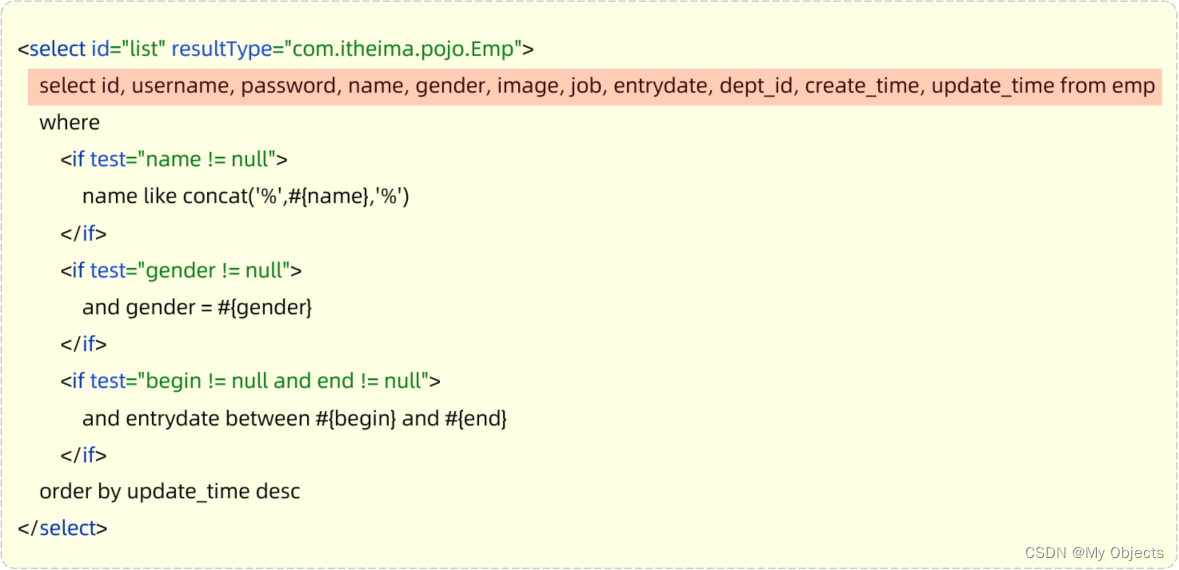

对重复的代码片段进行抽取,将其通过
<sql>
标签封装到一个SQL片段,然后再通过
<include>
标签进行引用。
-
<sql>
:定义可重用的SQL片段 -
<include>
:通过属性refid,指定包含的SQL片段

SQL片段: 抽取重复的代码
<sql id="commonSelect">
select id, username, password, name, gender, image, job, entrydate, dept_id, create_time, update_time from emp
</sql>
然后通过
<include>
标签在原来抽取的地方进行引用:
<select id="list" resultType="com.itheima.pojo.Emp">
<include refid="commonSelect"/>
<where>
<if test="name != null">
name like concat('%',#{name},'%')
</if>
<if test="gender != null">
and gender = #{gender}
</if>
<if test="begin != null and end != null">
and entrydate between #{begin} and #{end}
</if>
</where>
order by update_time desc
</select>
